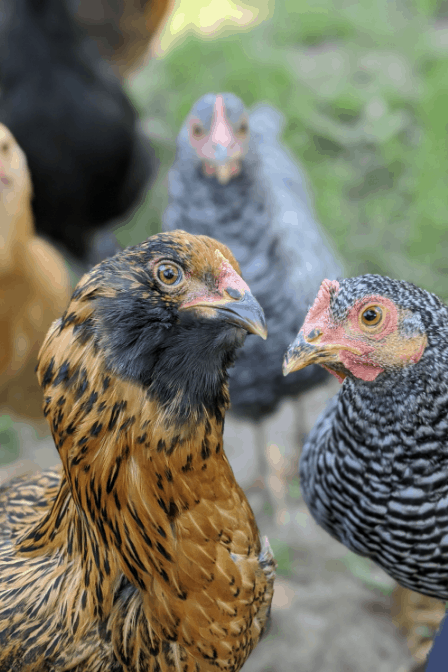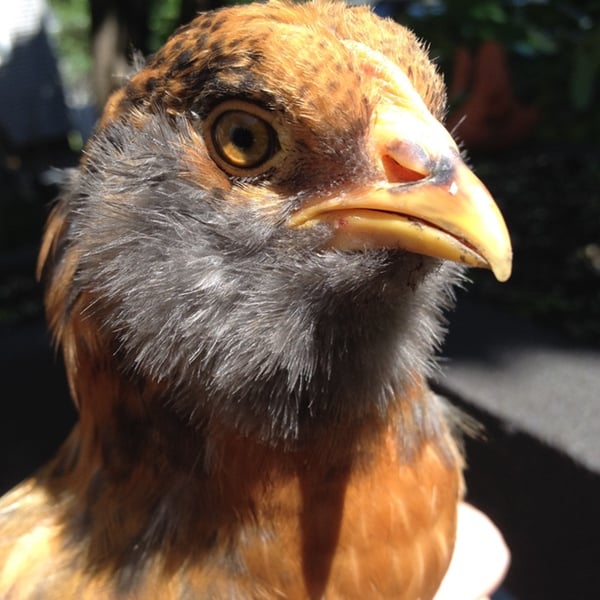How To Add Chickens To A Flock
Introducing new chickens to an already established flock tin be stressful for both the birds and you. The new flock will need to constitute a new pecking order, which can be actually tough for everyone involved.
Whether you're expecting a batch of new chicks or bringing abode a few mature hens, it's proficient to be prepared ahead of time and know the steps to introduce these new birds to your flock.
Through much experimentation over the years, we've developed a great strategy for new flock integration. This strategy allows the birds to go used to each other gradually, so there's less stress. We've used this method to introduce both new chicks and young birds to our older hens and it has been proven to be the all-time way to integrate.
This post contains chapter links.

Introducing New Chickens to the Flock
Before you begin these steps, and in fact before you lot even bring home new infant chicks or mature birds, y'all demand to make sure you have plenty space in your existing coop for the number of chickens that will live in that location.
Chickens on boilerplate demand at least 3 square feet of coop space, but more is ameliorate.
If y'all have a small coop for your current flock you lot'll demand to add some space before bringing home new chickens.
You can do this past adding on a large chicken run, building a separate pen, making a craven tractor, or tearing down the former coop and building a new ane.
Either way, you lot demand to make sure that your chickens will have plenty of space , because these steps will simply atomic number 82 to flock harmony if your chickens aren't stressed in a too-pocket-size coop.

Step Ane: Quarantine
All new members of the flock must exist quarantined before being added to an established backyard flock.
Quarantine is done to ensure that the new flock members aren't bringing in diseases or pests to your flock. They'll need to be examined daily to look for signs of mites and lice, as well every bit common poultry diseases.
Quarantine should last for at least 30 days.
I know this seems like a actually long fourth dimension, but many chickens don't show signs of carrying disease for several weeks, and many pests similar lice could take a week or more to hatch and prove up on your chickens.
It's well worth it to keep your new hens away from your older chickens during this time so your beloved older birds don't get sick.
To quarantine new chickens, continue them in an isolated area where they aren't sharing space with the existing flock. A dog crate or big beast cage inside the firm or garage will work well, or if you take a divide coop, all the better!
Be certain to launder your hands thoroughly in between handling new birds and the residual of the flock. You don't want to inadvertently pass on diseases or pests.
After the quarantine catamenia is up and yous're absolutely sure your new flock members are perfectly healthy, y'all can begin introducing new chickens to the residual of the flock.
Still unsure whether yous desire to quarantine? Don't miss this post from our friends at 104 Homestead on what could happen if you don't!

Step Two: Cage Within of the Coop
The next step is to place the new birds in a big animate being muzzle inside the coop. If you don't accept a cage, fence off a corner of the coop for the new birds, making sure they're protected on all sides, too as the top. Recollect chickens can jump and fly!
Placing the cage in a corner is a adept idea, so only ii walls of the cage are exposed to the rest of the flock.
The existing flock members will come up to investigate the new additions, only won't be able to get also close. This will allow everyone to conform to each other gradually without any take a chance of fighting or serious injuries.
In that location will be some pecking through the muzzle wires, and this is normal, natural, and completely fine. The old hens are showing the new girls that they're at the lesser of the pecking lodge.
Proceed the new flock members inside the cage for the starting time seven-14 days.
The pecking and general interest in the new girls should fade twenty-four hour period by twenty-four hour period. Eventually your old chickens I will mostly ignore the new birds in the cage.
If it seems everyone is getting along well after seven days, move onto step three. If there is still a lot of pecking going on through the cage, continue them in there for a few more days. It'due south better to accept these steps more slowly than to rush through them.

Pace Iii: Free-Range Fourth dimension
When step two is complete and the birds are all comfortable with each others presence, it's time to let them gratuitous range together.
This step allows all the birds to mingle in a place where they have enough of space to get away from each other if they demand, and lots of distractions to keep them from picking on each other too much.
Nosotros generally don't let new chickens out to free range until they've been in the coop for at least two weeks. This gives them time to acclimate to their new home and recognize the hen business firm as a safe place. When we do let the new hens out to free range, they know to get right dorsum to the coop if they feel threatened.
We like to let the old birds and the new birds out to free-range together for around an hour per day. This will give them time to collaborate with each other, and space to become some privacy if they need it. If you don't free range your flock, allow the new chickens out of their cage and into the run for an hour a twenty-four hours.
Information technology's important to supervise this fourth dimension together then y'all can arbitrate if needed.
If the new birds don't rush out of the muzzle the offset time you open it, give them fourth dimension. They may be frightened of the newfound infinite, but they will come out when they're set.
When the birds aren't gratis-ranging together, keep the new flock members in the muzzle, including at night.
Continue letting the flock free-range together for a week or so, increasing the time they spend together outside. Timing is different for everyone, so when all seems well, move onto footstep four.
This step can be a petty tough for anybody. It's very probable that there will be some craven fights now that the birds all have admission to each other. It'south okay if a little fighting happens, this is how chickens institute dominance, it'due south natural, normal, and necessary. If information technology goes besides far, separate the fighting chickens or distract them.

Pace Iv: Cage Door Open
After a calendar week of free-ranging together, open the door to the cage and leave it open up. The new flock members can come up and become from the cage every bit they delight. It volition still be a rubber place for them to go when they need, and they'll probable nonetheless sleep there at nighttime. The entire flock can at present mingle together whenever they delight. Continue letting them out to free range together.
If you are introducing babe chicks to a flock of older birds, it's a adept idea to make the door to the cage smaller so just the chicks can get through. You can do this past attaching some cardboard to the wire.
This allows the chicks to take their ain little clubhouse that the big girls can't get into, which keeps them safety. Don't be alarmed if your new chickens still get pecked at once in awhile. This is totally natural and necessary as the flock adjusts.
Remember that chickens aren't the same every bit people, and their social gild works in a unlike fashion. This method is meant to brand this transition easier for everyone, but there will nevertheless be some aligning before the birds are all comfortable with each other.

Tips for Introducing New Chickens into the Flock
Add a 2nd roost in the coop if necessary
The new birds may get pecked when they start trying to roost. Give some extra room and then anybody can roost comfortably.
Provide places for new flock members to get some privacy
Placing roosting bars high up in the run tin allow a safe place. Another option is to leave covered spaces inside the coop for birds to retreat to if they're getting picked on.
Keep an heart on the new birds
Look for signs that they're getting pecked too much. Missing feathers, wounds, or bleeding are a bad sign and those birds will need a little extra fourth dimension and TLC to get established.
Don't introduce tiny chicks to adult birds
If you're introducing chicks to a flock of adult birds, wait until they're at least six weeks former, but 8 weeks or older is ameliorate. The chicks tin get killed by the bigger birds if they aren't big enough to defend themselves.
How To Add Chickens To A Flock,
Source: https://backyardchickenproject.com/introducing-new-chickens/
Posted by: barnetthiscon.blogspot.com


0 Response to "How To Add Chickens To A Flock"
Post a Comment